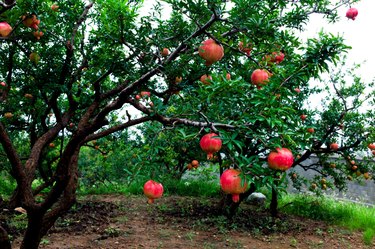
Pomegranates became wildly popular in the early to mid-2000s. They started showing up in large numbers in grocery stores, and pomegranate juices and syrups become widely available. Some of the fruit's popularity is probably due to its nutritional content.
Pomegranates are a good source of fiber and they are high in potassium and vitamin C, according to the Pomegranate Council. They are also full of antioxidants, which are now known to be useful for preventing heart disease and cancer. Although not suitable for all climates, pomegranate trees can make a nice addition to your own backyard garden in many areas, giving you your own supply of the healthy fruit.
Video of the Day
Video of the Day
Climate
Pomegranates grow in locations with tropical or warm and temperate climates. They will grow best, though, in locales with hot, dry summers and cool winters, according to the University of Florida IFAS Extension. The trees are more sensitive to cold weather than hot. Frost tolerance varies by species, but in general, they may be able to tolerate temperatures that range from 10 degrees Fahrenheit to 18 degrees Fahrenheit, though they might be damaged even at the higher end of this range.
Soil
Pomegranate trees will grow best in a well-draining soil, according to the Texas A&M University Extension. The best soils for the fruit trees are heavy loams, but they are able to tolerate a wide array of soil conditions and can even grow in clay or sandy soils. Optimal soil pH for pomegranate trees is 5.5 to 7. Alkaline soils can limit and restrict growth.
Light
Pomegranates require full sun to grow and thrive. You should plant the tree in the sunniest and warmest place of your yard if possible, California Rare Fruit Growers advises. In suitable climates, pomegranate trees will tolerate partial shade, but the sunnier the conditions are, the better.
Water
Pomegranate trees can tolerate dry conditions once they are well established. When rainfall is scant, water your tree every week to ten days. The ground should be sufficiently moist, the University of Florida IFAS Extension advises. In the period immediately after planting, the tree will require more care, which means more watering is necessary every couple of days to allow the roots to become well established.
Planting
Pomegranate trees should be planted in late winter or early spring, but after the date of the last frost, according to the University of Florida IFAS Extension. They should be planted in moist but not very saturated soil. Container-grown trees should be planted at the same depth they were originally grown. If you are planting pomegranate trees for hedges, space them at least 6 feet to 9 feet apart. For orchards, plant individual trees 15 to 18 feet apart.